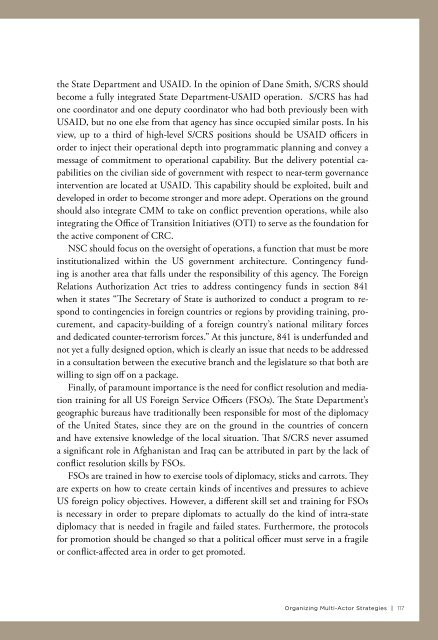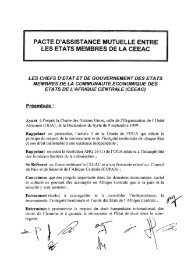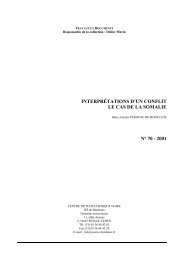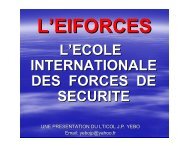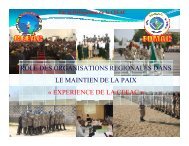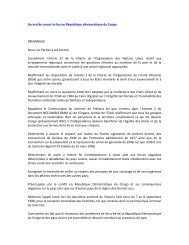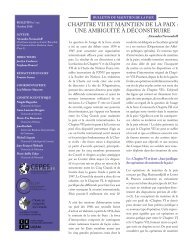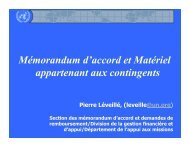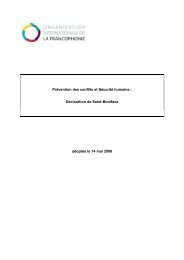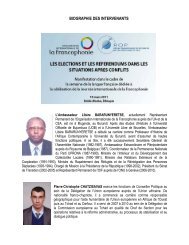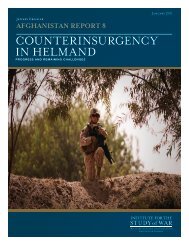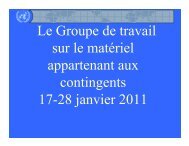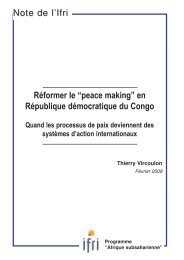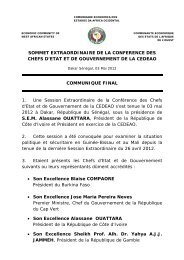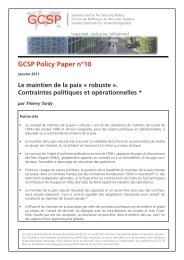engaging fragile states - Woodrow Wilson International Center for ...
engaging fragile states - Woodrow Wilson International Center for ...
engaging fragile states - Woodrow Wilson International Center for ...
Create successful ePaper yourself
Turn your PDF publications into a flip-book with our unique Google optimized e-Paper software.
the State Department and USAID. In the opinion of Dane Smith, S/CRS should<br />
become a fully integrated State Department-USAID operation. S/CRS has had<br />
one coordinator and one deputy coordinator who had both previously been with<br />
USAID, but no one else from that agency has since occupied similar posts. In his<br />
view, up to a third of high-level S/CRS positions should be USAID officers in<br />
order to inject their operational depth into programmatic planning and convey a<br />
message of commitment to operational capability. But the delivery potential capabilities<br />
on the civilian side of government with respect to near-term governance<br />
intervention are located at USAID. This capability should be exploited, built and<br />
developed in order to become stronger and more adept. Operations on the ground<br />
should also integrate CMM to take on conflict prevention operations, while also<br />
integrating the Office of Transition Initiatives (OTI) to serve as the foundation <strong>for</strong><br />
the active component of CRC.<br />
NSC should focus on the oversight of operations, a function that must be more<br />
institutionalized within the US government architecture. Contingency funding<br />
is another area that falls under the responsibility of this agency. The Foreign<br />
Relations Authorization Act tries to address contingency funds in section 841<br />
when it <strong>states</strong> “The Secretary of State is authorized to conduct a program to respond<br />
to contingencies in <strong>for</strong>eign countries or regions by providing training, procurement,<br />
and capacity-building of a <strong>for</strong>eign country’s national military <strong>for</strong>ces<br />
and dedicated counter-terrorism <strong>for</strong>ces.” At this juncture, 841 is underfunded and<br />
not yet a fully designed option, which is clearly an issue that needs to be addressed<br />
in a consultation between the executive branch and the legislature so that both are<br />
willing to sign off on a package.<br />
Finally, of paramount importance is the need <strong>for</strong> conflict resolution and mediation<br />
training <strong>for</strong> all US Foreign Service Officers (FSOs). The State Department's<br />
geographic bureaus have traditionally been responsible <strong>for</strong> most of the diplomacy<br />
of the United States, since they are on the ground in the countries of concern<br />
and have extensive knowledge of the local situation. That S/CRS never assumed<br />
a significant role in Afghanistan and Iraq can be attributed in part by the lack of<br />
conflict resolution skills by FSOs.<br />
FSOs are trained in how to exercise tools of diplomacy, sticks and carrots. They<br />
are experts on how to create certain kinds of incentives and pressures to achieve<br />
US <strong>for</strong>eign policy objectives. However, a different skill set and training <strong>for</strong> FSOs<br />
is necessary in order to prepare diplomats to actually do the kind of intra-state<br />
diplomacy that is needed in <strong>fragile</strong> and failed <strong>states</strong>. Furthermore, the protocols<br />
<strong>for</strong> promotion should be changed so that a political officer must serve in a <strong>fragile</strong><br />
or conflict-affected area in order to get promoted.<br />
Organizing Multi-Actor Strategies | 117


